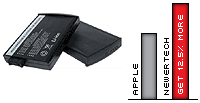The battery in my heretofore trusty PowerBook
G3 Pismo croaked last week. At least I think that's the
problem.
I unplugged the computer the night Hurricane Juan blew through in
case we experienced electric power issues. The next day I noticed
that the sleep light was not flashing, which was unexpected, as the
computer was booted into OS 9.1, which usually will last for weeks
asleep on battery power.
I plugged the AC adapter back in, and the Pismo booted up
normally, although the PRAM settings had reverted to defaults. The
little lightning bolt battery charge indicator came on, but after an
hour very little charge progress had been achieved. I put the 'Book
to sleep, and when I returned the next day, the battery was
completely dead, with zero charge indicated, and when I pulled the AC
adapter, the computer shut down.
Upon reboot, the PRAM settings had again reverted to defaults,
indicating that the zero charge readout was not kidding. None of the
little charge state lights on the battery are illuminated either.
Resetting the Power Manager Unit didn't change anything. Neither did
rebooting onto OS X.
Come to think of it, I had noticed that the palm rest area over
the battery compartment had seemed unusually warm when the PowerBook
was sleeping over the past couple of weeks or so, which may have been
a warning that the battery was in failure mode.
Lithium Ion battery behavior is a mystery to me.
The Pismo is just a few days short of its three year manufacture
date anniversary, and the battery has not had a lot of
discharge/recharge cycles, so if the problem is the battery (rather
than, say, PMU circuitry), that seems like a disappointingly short
life span. The original NiMH battery in my (now my daughter's) old
1996 PowerBook 5300 is still going
strong, but I guess that LiIon units are not as hardy.
Anyhow, in the absence of another Pismo/Lombard battery available
to try in this neck of the woods, the first logical step seems to be
procuring a replacement battery to try. As it turns out, there are a
number of replacement Pismo batteries offered by a variety of
resellers, with prices ranging from about $129 to $195.
One possibility that intrigued me is the new line of high-capacity
batteries designed for PowerBook G4 and G3 models introduced by Newer
Technology, Inc. (NewerTech) and Other World Computing (OWC) a couple
of weeks ago.
The NuPower line of Lithium Ion batteries offers up to 30 percent
more capacity than Apple's stock PowerBook batteries, and the
companies claim that they deliver the longest run times of any
replacement batteries available today.
 NuPower
LiIon G3 Batteries for G3 Lombard
(1999/Bronze Keyboard) and G3 FireWire (2000/Pismo) series
PowerBooks sell for $149.99, which is about middle-of-the-road for
Lombard/Pismo replacement batteries, and they are rated at 10.8 volts
and 5400 mAh, providing an advertised 12.5% more capacity versus
stock Lombard and FireWire batteries.
NuPower
LiIon G3 Batteries for G3 Lombard
(1999/Bronze Keyboard) and G3 FireWire (2000/Pismo) series
PowerBooks sell for $149.99, which is about middle-of-the-road for
Lombard/Pismo replacement batteries, and they are rated at 10.8 volts
and 5400 mAh, providing an advertised 12.5% more capacity versus
stock Lombard and FireWire batteries.
While 12.5% extra run time is nothing to sniff at, it's
significantly less than the boost NuPower batteries for the PowerBook
WallStreet (25 percent) and PowerBook G4 Titanium (30 percent) offer
- and the Lombard/Pismo unit sells for $10 more than the others.
This must have something to do with its smaller physical size.
NewerTech NuPower batteries are available through OWC
and at other resellers in the US and around the globe. Visit
NewerTech
for additional information.
Good places to comparison shop for laptop batteries are ComparesPrices.com
and NexTag.com.
Incidentally, Apple recommends that you calibrate
PowerBook and iBook batteries for best performance
The Lithium Ion battery of an iBook or PowerBook computer has an
internal microprocessor that provides an estimate of the amount of
energy in the battery during charging and discharging. The battery
needs to be recalibrated from time to time to keep the onscreen
battery time and percent display accurate. You should perform this
procedure when you first use your computer and then every few months
thereafter.
Follow these steps:
- Plug the power adapter in and fully charge your computer's
battery until the battery indicator lights turn off and the
adapter plug ring goes from amber to green, which indicates that
the battery is fully charged.
- Disconnect the power adapter and use your iBook or PowerBook.
When your battery gets low, you will see the low battery warning
dialog on the screen. Continue to use your computer until it goes
to sleep. At that point the battery has been sufficiently drained
for calibration.
- Connect the power adapter and leave it connected until the
battery is fully charged again.
Note: You have to fully charge and then discharge your battery
only once to calibrate it. After that, you can connect and disconnect
the power adapter when the battery is at any charge level.
When the battery reaches empty, the computer is forced into sleep
mode. The battery actually keeps back a reserve beyond empty to
maintain the computer in sleep for a period of time. Once the battery
is truly exhausted, the computer is forced into shutdown. At this
point, any open files could be lost. Therefore, it is important that
you find an electrical outlet and connect the adapter before the
forced shutdown occurs.
While that NuPower extra capacity battery look like a pretty good
deal, in my searches I found that Wegener
Media offers pulled and tested OEM Pismo batteries for
$119.99, and I've decided to go with one of those.
Now, here's keeping my fingers crossed that the only problem is
with the battery itself, and not something in the Power Management
Unit.

 NuPower
LiIon G3 Batteries for
NuPower
LiIon G3 Batteries for 
